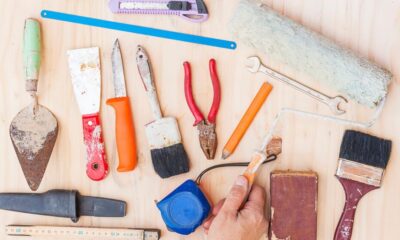BLOG
Exploring the West Seattle Blog, Your Guide to Local News and Community Updates

West Seattle is more than just a part of Seattle—it’s a vibrant community with its own stories, culture, and events. For those looking to stay connected with everything happening in this dynamic neighborhood, the West Seattle Blog has become an essential resource. Whether you’re a long-time resident or a curious newcomer, this blog keeps you informed, connected, and engaged.
This post explores the West Seattle Blog, showcasing its role in the community, the essential topics it covers, and why it’s a trusted source of hyperlocal news. Plus, we’ll highlight ways you can interact with and contribute to this valuable community hub.
What is the West Seattle Blog?
The West Seattle Blog (WSB) is a well-established hyperlocal news website dedicated exclusively to life in West Seattle. Founded in 2005, WSB has grown into a go-to source for real-time updates, detailed coverage of local issues, and community-driven discussions. It’s not just a blog—it’s a living, breathing resource that captures what makes West Seattle unique.
Why Hyperlocal News Matters
With the rise of major news outlets and global stories, hyperlocal news platforms like WSB fill a crucial gap. They allow residents to focus on the unique happenings in their corner of the world. From road closures to new restaurant openings, this kind of news fosters a stronger connection between people and their neighborhoods.
For West Seattle specifically, this means having a reliable guide to events, public safety updates, development projects, and more—all tailor-made for the community.
The Key Topics Covered by the West Seattle Blog
One reason WSB resonates with its audience is its diverse and relevant coverage. Here are some of the key areas it consistently covers:
1. Community News
From neighborhood council meetings to updates on parks and recreation, WSB offers comprehensive coverage of local stories that matter. Whether the focus is on community cleanups or celebrations, it ensures West Seattle residents are always in the loop.
2. Traffic Alerts and Transportation Updates
West Seattle faces its own unique transportation challenges, particularly with ongoing projects like the West Seattle Bridge repair. The WSB has become one of the most trusted sources for real-time traffic alerts, public transit updates, and alternative route suggestions.
For busy commuters, the blog’s timely updates are indispensable. It’s not uncommon for WSB readers to check the site before leaving home to avoid unexpected delays.
3. Public Safety
Staying safe is a top priority for any community. The WSB frequently reports on police activity, school safety, weather emergencies, and fire department updates. The blog’s commitment to transparency ensures that residents have the information they need to make informed decisions.
4. Business Openings and Closures
West Seattle is home to a thriving small business scene, and WSB celebrates it by spotlighting new openings, closures, and changes to beloved local businesses. Not only does this support local entrepreneurs, but it also helps residents discover hidden gems in their area.
For instance, whether a new coffee shop has debuted or a longstanding eatery is saying goodbye, WSB ensures the community is aware.
5. Events and Activities
From neighborhood festivals to school fundraisers, the WSB keeps track of events that bring people together. Their event calendar is a treasure trove of opportunities to connect with others and experience the culture of West Seattle.
6. Local Voices and Perspectives
WSB amplifies the voices of locals by sharing letters, opinion pieces, and photos submitted by the community. This collaboration fosters a sense of belonging and ensures a diversity of stories is represented.
What Makes the West Seattle Blog Stand Out?
While there are many ways to get news these days, the WSB stands out for several reasons:
Real-Time Updates
WSB is known for providing updates as events unfold. For example, during the West Seattle Bridge closure, the blog became a primary source of live information, earning trust and respect from the community.
A Trusted Voice
Run by local journalists who understand the nuances of the area, WSB ensures accuracy and transparency in its reporting. This credibility has kept readers coming back for nearly two decades.
Active Community Engagement
WSB isn’t just about disseminating information—it’s about creating dialogue. The comments section often serves as a space for neighbors to connect, debate, and collaborate towards solutions.
Comprehensive yet Accessible
Despite covering a wide array of topics, the blog remains easy to navigate. Whether you’re looking for restaurant recommendations or public meeting details, the content is well-organized and user-friendly.
How You Can Engage with the West Seattle Blog
WSB isn’t a one-way street—it thrives on reader contributions and engagement. Here’s how you can join the conversation:
Submit Your Stories
If you have a local story, event, or perspective to share, reach out to the blog’s editors. By doing so, you’ll contribute to the wealth of community knowledge.
Comment and Discuss
Join the comments section to share your thoughts or engage with others. The community-powered nature of WSB is one of its greatest strengths.
Follow on Social Media
Stay updated on the go by following the blog’s social media accounts. Their Twitter feed, for instance, is excellent for real-time updates.
Attend Featured Events
Keep an eye out for community events promoted on the blog. Attending these gatherings is a fantastic way to connect with your neighbors.
Why the West Seattle Blog is a Model for Local News
The success of WSB highlights the power of locally focused journalism. Communities worldwide could take note of its dedication to transparency, community involvement, and timely reporting.
For residents and businesses in West Seattle, the blog isn’t just a source of news—it’s a pillar of connection. It reminds us all of the value in staying tuned to what’s happening right in our backyards.
Stay Connected with the WSB
Whether you’ve lived in West Seattle for decades or just moved to the area, the West Seattle Blog is an indispensable resource for staying connected and informed. Take a moment to explore the site, contribute to the conversation, and engage with your vibrant community.
Always Stay Connected
Bookmark the West Seattle Blog and make it part of your daily routine. You’ll never miss out on the stories, events, and updates that define this amazing neighborhood.
BLOG
Magnum PI Hawaiian Shirt: A Timeless Icon of Style and Culture
For decades, the Magnum PI Hawaiian Shirt has been more than just a piece of clothing—it’s been a symbol of laid-back island vibes, individuality, and effortless cool. And in the realm of pop culture, no Hawaiian shirt stands out more than the iconic red-and-black patterned one worn by Tom Selleck in the 1980s TV show Magnum, P.I.. The shirt isn’t just another piece of fabric; it’s a tribute to a bygone era, a fan favorite, and a timeless icon that continues to captivate new generations of fashion enthusiasts.
But what makes the Magnum PI Hawaiian shirt so legendary? Let’s take a closer look at its history, its cultural resurgence, and tips for incorporating this bold style icon into your wardrobe today.
The Story Behind the Magnum PI Hawaiian Shirt
The Origin of the Iconic Shirt
The Hawaiian shirt—or Aloha shirt—is steeped in history. Its origins date back to the 1930s in Hawaii, where it emerged as a fusion of Japanese-inspired designs and Western-style tailoring. Over time, the shirts evolved to reflect Hawaii’s local culture, often featuring bright florals, tropical scenery, and bold colors.
When Magnum, P.I. premiered in 1980, the show captured the beauty, mystery, and laid-back lifestyle of Hawaii. And at its center was private investigator Thomas Magnum, played by the effortlessly charismatic Tom Selleck. Selleck’s Hawaiian shirt, produced by a local brand called Paradise Found, featured a red base with black jungle bird motifs—a bold look that perfectly matched Magnum’s easy-going yet fearless personality.
The shirt came to define Magnum’s image. It wasn’t just wardrobe—it was a character unto itself, representing Hawaiian culture, adventure, and Selleck’s unique blend of humor and rugged charm.
How the Shirt Gained Cult Status
The Magnum, P.I. Hawaiian shirt exploded into pop culture, thanks to the show’s global popularity throughout the 1980s. Tom Selleck’s mustachioed charm paired with this bold and carefree look resonated with viewers, transforming the shirt into an unmistakable icon.
Fashion aficionados embraced it for its distinct pattern and saturated hues, while TV fans sought to emulate Magnum’s swagger. Over the years, celebrity endorsements and nostalgic reboots have kept the shirt alive as a beloved pop culture relic.
Now, decades later, the Magnum PI Hawaiian shirt transcends mere costume status—it remains a symbol of individuality, nostalgia, and unconventional style.
Why the Magnum PI Hawaiian Shirt Endures
Some fashion icons fade away as the decades pass, but the Magnum PI Hawaiian shirt has managed to hold its own. Why has it remained relevant while other trends have fallen by the wayside?
The Power of Nostalgia
The resurgence of 1980s and 1990s fashion trends has fueled the Magnum PI Hawaiian shirt’s comeback. Millennials and Gen Z, drawn to the aesthetics of the past, are finding inspiration in retro styles that exude authenticity and personality. The shirt serves as a reminder of a simpler time when bold statements were unapologetically embraced.
An Expression of Individuality
The Hawaiian shirt worn by Tom Selleck isn’t just visually striking—it’s a defiant statement against conformity. Unlike plain, muted tones often seen in conventional menswear, the Magnum PI Hawaiian shirt’s bold pattern and bright colors invite the wearer to stand out and break societal norms.
A Blend of Comfort and Confidence
Fashion trends come full circle when a piece offers equal parts style and function. The Magnum shirt does both. Its lightweight fabric and relaxed fit make it practical and breathable—ideal for hot climates or casual outings. Pair that with its vibrant design, and you get a timeless piece that allows people to feel both confident and comfortable.
How to Style a Magnum PI Hawaiian Shirt
If you’re inspired to channel your inner Magnum, here’s how you can rock the iconic Hawaiian shirt with contemporary finesse while staying true to its retro vibes:
1. Keep It Casual
Pair the Hawaiian shirt with simple denim shorts or relaxed-fit khakis for that classic island flair. Add a pair of boat shoes or sandals, and you’re good to go for a weekend barbecue or a casual night out. Roll up your sleeves for an extra laid-back touch.
2. Layer It… Like a Pro
Not quite ready to rock the shirt as a standalone statement? Try layering it. Leave it unbuttoned over a plain white or black T-shirt to create a bold yet approachable aesthetic.
3. Elevate with Tailoring
For those seeking to add sophistication to the fun look, consider layering the Hawaiian shirt under a linen blazer. Opt for neutral-colored trousers and loafers to balance the casual and polished elements, making this the perfect outfit for summer evenings.
4. Match the Vibes
Keep accessories true to the Magnum spirit. A pair of aviator sunglasses instantly channels Tom Selleck’s iconic swagger, while a simple leather strap watch completes the look in subtle style.
5. Less Is More
The shirt is already a head-turner, so keep the rest of your outfit understated. Stick to solid colors for pants, shoes, and accessories—this allows the shirt to remain the focal point.
Where to Find Your Own Magnum PI Hawaiian Shirt
Hunting for your very own Magnum PI-inspired Hawaiian shirt? Look no further! Many retro fashion retailers specialize in vintage Paradise Found designs, recreating the classic red jungle bird pattern. Online platforms like eBay and Etsy also feature original prints for the nostalgic collector.
Alternatively, modern brands now pay homage to the original Magnum design, infusing it with slight updates to cater to today’s trends. Whichever option you choose, don’t hesitate to add your personal twist.
The Magnum PI Shirt’s Legacy in Pop Culture
From TV screens to modern-day Instagram posts, the Magnum PI Hawaiian shirt proves that style, when done authentically, never truly fades. It has graced costume parties, inspired fashion designers, and even popped up in countless parodies and tributes.
Fashion influencers on platforms like TikTok and Instagram have reignited the popularity of Hawaiian shirts, often referencing Magnum’s iconic red-and-black look. Meanwhile, reboots of Magnum, P.I. have introduced Magnum’s style (and shirt) to a whole new generation of fans.
Longtime fans of the show will always appreciate the sentimental ties to Tom Selleck, but new fans see it as a way to add fun, vibrancy, and personality to their wardrobe.
Make a Bold Statement with Magnum Style
The Magnum PI Hawaiian shirt isn’t just a piece of clothing—it’s a symbol of individuality, confidence, and the timeless allure of living life your own way. Whether you’re a diehard Magnum, P.I. fan or new to this retro trend, the Magnum shirt offers an easy way to inject your wardrobe with nostalgic appeal and adventurous spirit.
Why not add a splash of Magnum-style boldness to your closet? Trust us—it’s a conversation starter you won’t regret.
Whether thrown over a T-shirt or tucked perfectly into crisp chinos, the Magnum PI Hawaiian shirt’s vibrant colors and rich cultural history keep it firmly planted as a timeless piece of fashion. Time to decide—are you ready to bring a piece of TV history into your everyday looks?
BLOG
Moddroid Mechat: The Ultimate Resource for Gamers and Developers

Gaming and app development have always thrived on innovation and creativity. Whether you’re a casual gamer or a developer eager to stay ahead of the curve, having a platform that combines a rich variety of modified apps, game tools, and an insightful community is a game-changer. Enter Moddroid Mechat, a powerhouse resource catering to both gamers and developers, offering features that redefine interaction, exploration, and customization in the digital landscape.
This blog will explore what makes Moddroid Mechat the ultimate hub for gamers seeking enhanced gaming experiences and developers striving to perfect their creations. From the platform’s offerings to its practical use cases, we’ll cover it all.
What is Moddroid Mechat?
At its core, Moddroid Mechat is a platform built for anyone who loves games or creates them. It combines a vast library of modded apps and games with an active community dedicated to discussing mods, sharing techniques, and improving gaming experiences. The platform offers modded APKs (Android Package Kits) that rewind traditional limits, unlocking premium features, unlimited resources, and smoother functionalities.
For developers, Moddroid Mechat serves as a testing ground and community hub where feedback and interaction with users offer an avenue to refine their projects.
By bridging the gap between users and creators, Moddroid Mechat revolutionizes both app consumption and development.
Why Gamers Love Moddroid Mechat
Moddroid Mechat stands out from standard app stores, offering features designed to elevate the player experience from average to extraordinary. Here’s why:
1. Access to Modded Games and Applications
Gamers can find modded versions of their favorite apps and games, unlocking premium features that are typically hidden behind paywalls. Want more in-game currency? Need better characters or equipment? Moddroid Mechat makes it possible with just a click.
2. Enhanced Gaming Experiences
With mods that allow players to tweak game mechanics, graphics, and customizations, gamers experience titles like never before. For example, visual mods transform the aesthetic of basic games into jaw-dropping vistas, while performance mods eliminate lag for seamless gameplay.
3. Regular Updates for Popular Apps
Moddroid Mechat ensures their platform is always up-to-date with the latest versions of modded games, keeping players on the cutting edge. Plus, the dedicated team behind the platform constantly releases new content.
4. Vibrant Community
The platform fosters a supportive community where users can share feedback and strategies or request mod improvements directly from developers. The community aspect adds a layer of collaboration and friendship, transforming the gaming experience into something truly interactive.
5. Safe Downloads
When downloading modified APKs, security can be a concern. Moddroid Mechat ensures all APKs are scanned for potential risks, creating a safe environment for users to explore new games and features worry-free.
How Moddroid Mechat Helps Developers
Game and app developers looking to push boundaries will likewise find Moddroid Mechat an indispensable resource. Here’s how:
1. User Testing Environment
Moddroid Mechat doubles as a testing space where developers can showcase unreleased or beta versions of apps. Gamers provide hands-on feedback, helping developers identify bugs, user pain points, and areas for improvement early in the development process.
2. Community Insights
By observing in-depth discussions within the platform’s community, developers gain a better understanding of user desires. For instance, developers of a tactical RPG may notice players consistently requesting character customizations—valuable insights for future updates.
3. Faster App Iterations
Testing updates with Moddroid’s engaged user base accelerates the process of improving app quality. Developers can iterate quicker, fine-tuning software with regular feedback loops.
4. Real-Time Interaction with Players
Developers can communicate directly with end-users to discuss features, improvements, or technical fixes in real time. This transparency and collaboration strengthen bonds between developers and their audience.
5. Build Awareness for New Apps
Releasing apps on platforms like Moddroid Mechat increases visibility among enthusiastic early adopters who are eager to try new tools and games.
How to Use Moddroid Mechat
Getting started with Moddroid Mechat is simple, and almost anyone—from beginners to seasoned gamers and developers—can jump right in. Follow these steps to start reaping the rewards:
For Gamers:
- Create an Account
Sign up on the Moddroid Mechat platform to access its library and community features.
- Search for Your Favorite Games/Apps
Use the search bar to locate modded versions of your go-to apps.
- Download and Install
Click “Download,” follow the installation prompts, and ensure you’ve enabled “Unknown Sources” on your Android device if needed.
- Join the Community
Participate in discussions, leave reviews, and chat with other users to make the most out of your gaming experience.
For Developers:
- Sign Up as a Creator
Join Moddroid’s platform and mark yourself as a developer to share your projects.
- Upload Beta Versions of Your App
Make your game available for testers or beta users who provide valuable feedback.
- Engage with the Community
Respond to user questions, collect suggestions, and adapt your project based on player preferences.
- Track Analytics and Feedback
Use data from downloads, reviews, and user interactions to refine your app.
- Grow Your Brand
Leverage the platform to gain exposure and build a base of loyal users who’ll stick with your app development process.
Why Moddroid Mechat is a Game Changer
Moddroid Mechat isn’t just another app platform—it’s a dynamic ecosystem where gamers and developers thrive together. With its ability to elevate gaming experiences and assist in app development, it has positioned itself as an indispensable tool for anyone invested in games. Highlights include:
- Innovation for Gamers: Every download unlocks a new way to explore and enjoy games.
- Support for Developers: Connecting with a highly engaged community leads to insights and improvements.
- All-in-One Solution: From modding apps to fostering collaboration, Moddroid Mechat is a one-stop shop.
Final Thoughts—Transform Your Gaming or Development Journey
Whether you’re looking to enhance your gameplay or perfect your app, Moddroid Mechat’s offers the tools and community to help you succeed. With modded applications, personalized interaction, and safe downloads, this platform promises constant growth and excitement for gamers and developers alike.
Are you ready to join the Moddroid Mechat’s revolution? Jump in today—level up your gaming or development experience with features designed to keep you one step ahead of the curve!
BLOG
Husky Pro HDS500L1008: A Comprehensive Overview

One such tool that has garnered attention for its performance and reliability is the Husky Pro HDS500L1008. This article aims to provide a detailed overview of this model, its features, applications, and why it stands out in the market.
Husky Pro HDS500L1008, it is essential to understand the Husky Pro brand itself. Established as a prominent player in the tools and equipment industry, Husky Pro is widely recognized for producing high-quality products designed for both professionals and DIY enthusiasts. The brand focuses on innovation, durability, and functionality, ensuring that their tools can withstand even the toughest working conditions.
What is the Husky Pro HDS500L1008?
The Husky Pro HDS500L1008 is a versatile and powerful tool designed for automotive applications, specifically suited for mechanics and repair professionals. This model is well-regarded for its ergonomic design and robust features aimed at providing convenience and efficiency during work. Whether you are dealing with intricate automotive repairs or handling heavy-duty tasks, the HDS500L1008 stands out as a reliable choice.
Key Features of the Husky Pro HDS500L1008
1. Powerful Performance
One of the most notable aspects of the Husky Pro HDS500L1008 is its powerful motor. Engineered to deliver consistent performance, this tool is capable of handling a wide range of tasks. The high torque output makes it an excellent choice for loosening tough bolts or fasteners without straining the operator.
2. Ergonomic Design
Ergonomics play a pivotal role in the usability of any tool, and the Husky Pro HDS500L1008 does not disappoint in this department. The tool features a comfortable grip that reduces hand fatigue, allowing users to operate it for extended periods without discomfort. The lightweight design further enhances maneuverability, enabling easy access to tight spaces in an automotive setting.
3. Durability and Build Quality
Constructed with high-quality materials, the Husky Pro HDS500L1008 is designed to withstand the rigors of daily use. Its rugged construction ensures that it can handle rough handling and harsh working conditions, making it a durable investment for professionals.
4. Versatility
The Husky Pro HDS500L1008 is not limited to automotive applications. Its versatility allows it to be used in various other fields, including construction, maintenance, and even DIY projects at home. This multifunctional capability makes it a valuable addition to any toolbox.
5. Integrated Safety Features
Safety is a crucial consideration when using power tools. The Husky Pro HDS500L1008 is equipped with several safety features designed to protect users during operation. These include automatic shut-off mechanisms, heat resistance, and protective casings that prevent accidental contact with moving parts.
Applications of the Husky Pro HDS500L1008
Understanding the applications of the Husky Pro HDS500L1008’s can help potential users appreciate its value better. Here are a few areas where this tool shines:
Automotive Repair
As a go-to tool for mechanics, the Husky Pro HDS500L1008’s is ideal for automotive repairs, including changing tires, performing engine work, and handling general maintenance tasks. Its powerful performance and ease of use simplify what would otherwise be labor-intensive jobs.
Construction Projects
Contractors and construction workers can benefit from the HDS500L1008’s versatility. Whether it’s installing structural components or carrying out routine maintenance, the tool’s features are tailored for heavy-duty work.
Home DIYing
For homeowners who enjoy taking on projects themselves, the Husky Pro HDS500L1008’s offers the functionality needed for various tasks. From assembling furniture to making home improvements, it is a handy tool to have on hand.
Why Choose the Husky Pro HDS500L1008?
Enhancing Work Efficiency
One of the primary reasons to opt for the Husky Pro HDS500L1008’s is its ability to enhance work efficiency. With its powerful motor and user-friendly design, tasks can be completed more quickly and with less physical strain. This efficiency is especially crucial for professionals who rely on tools to maximize productivity.
Cost-Effectiveness
Investing in high-quality tools can lead to significant long-term savings. The durability and performance of the Husky Pro HDS500L1008’s ensure that it can withstand the test of time, reducing the need for frequent replacements and repairs. This makes it a cost-effective choice for both businesses and individuals.
Positive User Feedback
A significant indicator of a product’s reliability is user feedback. The Husky Pro HDS500L1008’s has received positive reviews from users for its performance and ease of use. User testimonials often highlight its efficiency in handling various tasks and its robust build quality.
Conclusion
The Husky Pro HDS500L1008 is more than just a tool; it’s an investment in efficiency and reliability. With its powerful performance, ergonomic design, and versatility, it stands out as a top choice for professionals and DIY enthusiasts alike.
-

 BLOG11 months ago
BLOG11 months agoWho Is the Father of CSK? A Deep-Dive Into Chennai Super Kings’ Dominance in Cricket
-

 EDUCATION11 months ago
EDUCATION11 months agoHighlights From the September 18 Board of Education Meeting
-

 PLATFORM10 months ago
PLATFORM10 months agoThe Ultimate Guide to MyDesi.Net – Where Culture Meets Connection
-

 EDUCATION11 months ago
EDUCATION11 months agoA Look Back at the Board of Education City of Linden 2020 and Manganello’s Impact
-

 HOME IMPROVEMENT10 months ago
HOME IMPROVEMENT10 months agoHome Depot Tool Rental, Everything You Need to Know
-

 BLOG10 months ago
BLOG10 months agoUnderstanding Missav: Everything You Need to Know
-

 TECHNOLOGY11 months ago
TECHNOLOGY11 months agoUnderstanding Mega-Personal.Net Technology and Its Applications
-

 TRAVEL11 months ago
TRAVEL11 months agoTravel Smarter with TravelsForNow, Your Guide to Exploring the World
